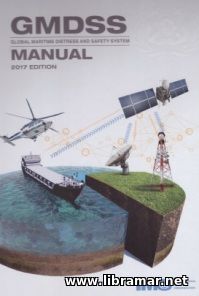 The latest release of the official GMDSS Manual. The present publication is published with the intention to provide, in a single and comprehensive volume, a thorough explanation of the principles upon which the GMDSS bases as well as to describe the radio-communication requirements together with the recommendations for implementation of the system, relevant operational performance standards supplemented by the technical specifications that shall be met by the GMDSS related equipment.
The document also covers the methods and procedures for the operation of the radio services forming the GMDSS. The Master Plan for the system has also been addressed. This edition of the Manual is fully updated. The content of the publication includes description of the technical concepts and history of development of the GMDSS, valuable excerpts taken from the relevant regulations of SOLAS convention, supporting regulatory documents such as circulars and resolutions related to the GMDSS.
In addition, there are ITU recommendations providing required technical details, the NAVTEX Manual, and many other information considered important and relevant enough for inclusion - in fact everything you need to be able to understand and use the GMDSS. The volume shall be used by the vessel personnel, shore supporting persons, regulatory bodies, administrations and all others engaged in ship communication in any way.
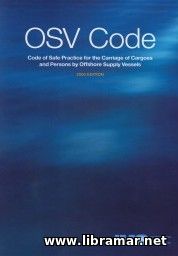 The OSV Code providing all required guidance for the safe transportation of people and cargo by OSVs, standing for the offshore supply vessels. The official IMO release approved by the MSC and adopted by the Assembly. The content of the present regulatory document concerns with the safe practice in the operation/management of the offshore supply vessels when they are interfacing with the offshore platforms and other types of installations.
The volume will also provide valuable practical guidance on items commonly covered by SMS and required by the ISM Code. The book starts with General chapter providing the introduction to the information, definitions and relevant documentation, communication, and handling of cargo.
The next three chapters making the main body of the document, are covering port operations including cargo and communications related matters, sea transport and offshore operations including the associated mooring requirements, communication, transfer of the personnel, cargo handling and other important aspects to be considered. Three appendices give some supplementary information such as the types and examples of installations, interfacing activities and color code used for the bulk substance hoses...
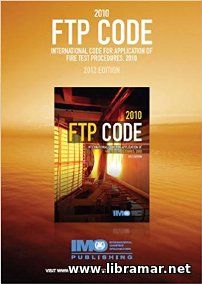 This is the 2012 edition of one of the most important IMO publications providing requirements to be considered during the application of the fire test procedures. The present Code was specifically developed with the ultimate goal to enhance its user friendliness and ensure uniform application of all requirements contained; another purpose was to generalize the experience which has been gained from application of Res. MSC.61(67).
The intention of the developers of the content of this regulatory document was to formulate all requirements applicable to the test procedures in a form close to the procedures commonly used in the industry. The material in the publication starts with the Res. MSC.307(88) covering the fire testing procedures and requirements to the testing labs and test reports, approval procedures and products allowed for installation with no testing and/or approval required, modern technology and equivalents etc.
It is followed by four annexes addressing all applicable requirements sin detail. The document applies to the products commonly required to be tested, evaluated and subsequently approved as per the FTP Code referenced in the SOLAS Convention...
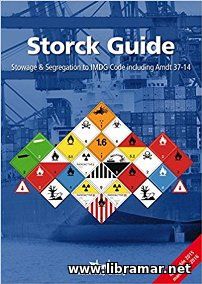 The dangerous goods transported on board seagoing ships shall necessarily be loaded in strict accordance with the established safety rules governing the segregation and stowage of the cargo per IMDG Code. This is quite easy to stipulate but usually very difficult to do. The specific information covering the relationship of different classes of hazardous goods in respect of the stowage/segregation of these goods is contained in hard-to-understand data tables of the Code.
The present Guide will provide all necessary assistance to the people engaged in stowage and segregation of the cargo on board ships and responsible for making the transportation safer. It shows the stowage with dangerous goods of the other classes and also provides information relating to the special segregation requirements applicable to the single substances of different classes, in fact all of them except for 1 and 7.
The document covers the rules for conventional cargo vessels, container carriers and Ro-Ro ships plus barges. All applicable IMO Security Provisions are incorporated. The arrangement of the material in this guide is similar to the arrangement in the Storck Guide for Stowage and Segregation to IMDG Code including Amendment 36-12.
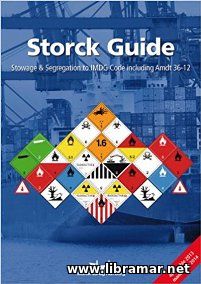 This guide book has been designed to provide a summary of both individual and general stowage/segregation requirements contained in the IMDG Code. It presents an extract of the subject Code containing all information commonly required by the people engaged in the stowage and segregation activities involving dangerous goods and/or hazardous materials intended to be carried on board sea going vessels.
To make using the document easier, its authors have printed the numbers of all relevant IMDG Code paragraphs. The document is intended for use by the workers of the packing stations and all other people involved including stevedores and cargo surveyors, terminal operators and ship planers, cargo officers etc. The content starts with the general introduction followed by the list of definitions and abbreviations used throughout the text of the guide, together with the units of measurement.
The next several chapters of the guide are devoted to the training and security provisions plus special procedures that would be normally applicable to particular materials, substances and articles. The dangerous goods carried packed in limited/excepted quantities have been addressed paying attention to their marking and all associated documentation, general stowage/segregation provisions, transportation of these cargoes on different types of ships including containerships, Ro-Ro and general cargo ships, and many other important issues.
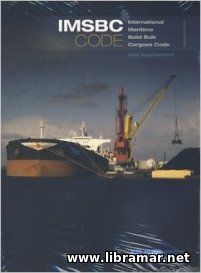 The primary purpose of the IMSBC Code replacing the BC Code is to duly facilitate the safe stowage/securing of the solid bulk cargo giving information on the hazards that are commonly associated with the transportation of solid bulk cargoes of different types and providing relevant instructions on the established procedures.
The content of this officially released regulatory document features fully up-to-date individual scheduled developed and implemented for the certain types of cargoes, including such specific types of cargo as granulated tire rubber, chopped rubber, plastic insulation material and others; the volume covers alternative form of sulphur and provides references to the provisions of SOLAS convention.
It also contains updated information migrated to here from the IMDG Code. The materials contained in the Code is arranged in thirteen sections starting from the general provisions section followed with the one dealing with general loading of the cargo, its transportation and precautions for unloading, safety of the vessel and crew members, trimming, liquefaction of cargo and associated testing procedures, security provisions, conversion of stowage factor and other important aspects. Four appendices provide required supplementary information.
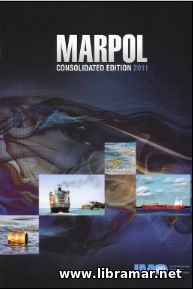 One of the most important conventions by IMO, i.e. International Maritime Organization. MARPOL Convention is devoted to the protection of the environment. The introductory general part of the Convention is outlines in the Protocols opening the document. The main provisions of the Conventions are contained in six Annexes to it.
The first Annex provides regulations for prevention of marine pollution by oil including requirements applicable to the machinery spaces and cargo areas, oil pollution incidents and reception facilities, special requirements that normally apply to the floating/fixed platforms, transfer of oil etc.
The second and third Annexes govern prevention of pollution by noxious liquid substances carried in bulk and by harmful substances carried in packaged form. The fourth and fifth Annexes deal with the sewage and garbage pollution while the last Annex solely addresses atmospheric pollution from the ships including emission control, operation and maintenance of the diesel engines, incinerators and other shipboard equipment, as well as availability and quality of the fuel oil. Each of the Annexes is arranged in standard form starting with the chapters with general information and regulations concerning survey, certification and control.
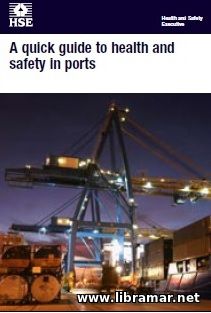 A compact booklet with the guidelines to the health and safety in marine ports released by the Health and Safety Executive. Most of the ports are challenging objects to work. People may be involved in transportation of different cargo types and working with different people when performing this tasks. It should be taken into account that some of those people may not speak English.
The work in ports does not stop, people work day and night, in any weather conditions. They often work under pressure to load and discharge the cargo quickly in order to catch a tide; sometimes speedy loading and unloading is required to get a wharf freed. The guidebook was actually released to highlight the main hazards commonly found in marine ports.
It is primarily aimed at the worker but will also be interesting and useful to the stakeholders and visiting drivers - in fact to everyone visiting docks and working there on a regular or occasional basis since the content of this small publication clearly outlines what they shall do to ensure compliance with the law requirements.
They will find, in a compact and simple form, the information about tackling the hazards, know what to do should the things go not as they were planned to, and get familiarized with the major hazards associated with the lifting operations, transportation etc.
« 1 2 ... 10 11 12 13 14 ... 24 25 » |







